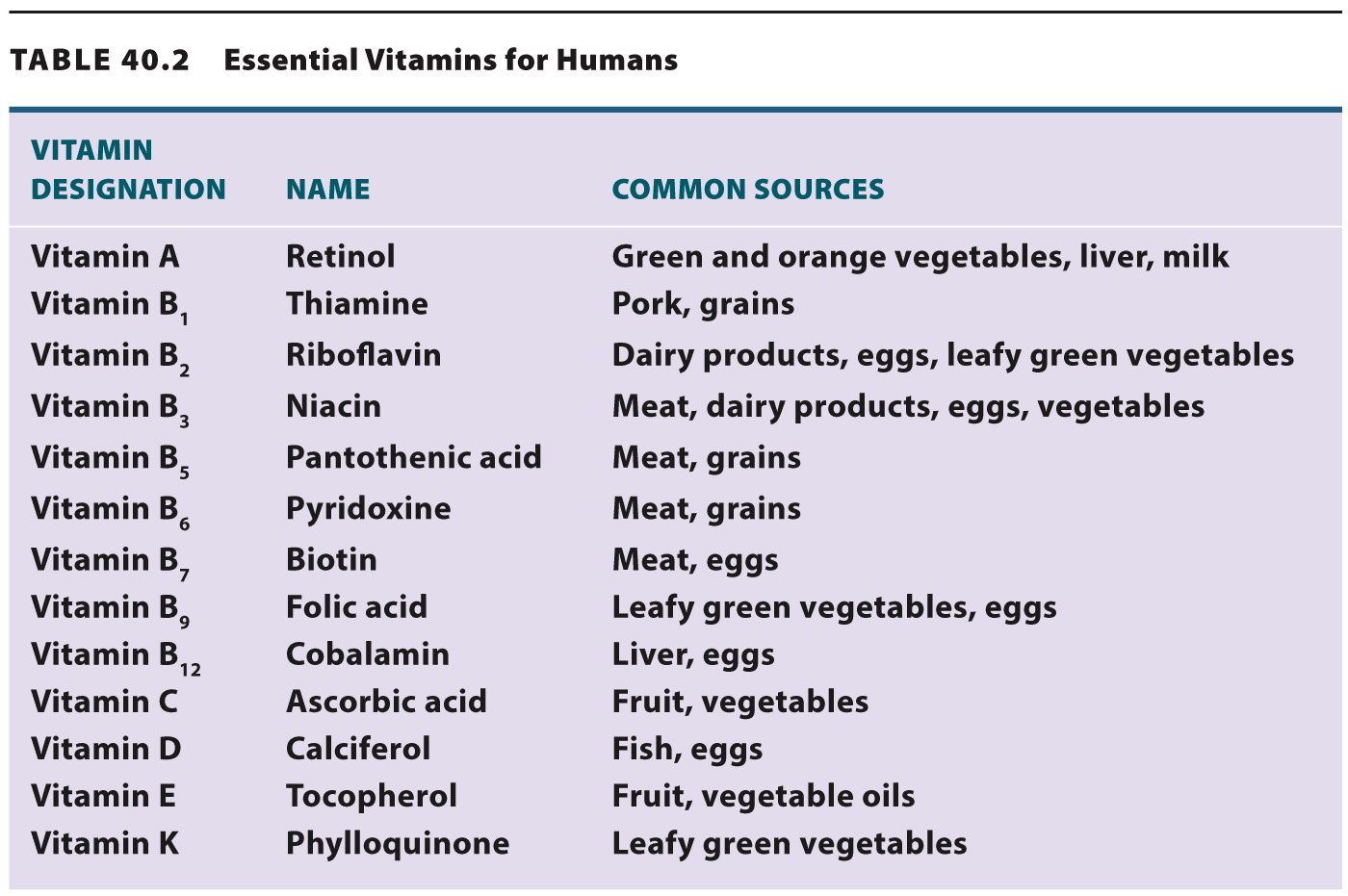An animal’s diet must supply nutrients that it cannot synthesize.
Through their metabolic pathways, animals are able to obtain energy from the environment as well as to synthesize many of the compounds needed to sustain life. However, many nutrients necessary for life cannot be synthesized by an animal’s metabolism and therefore must be acquired in the food that they eat.
Recall that amino acids are the basic units of proteins (Chapter 4). There are 20 different amino acids that are typically found in proteins (see Fig. 4.2). Although all of them are necessary for life, an essential amino acid is defined as one that cannot be synthesized by cellular biochemical pathways and instead must be ingested. Most animals can synthesize about half of their amino acids.
858
859
860
Humans are unable to synthesize 8 of the 20 amino acids (Table 40.1). We have to obtain these eight essential amino acids in our diets. Infants require additional amino acids. The most reliable source of all eight essential amino acids is meat. This is not to say that only omnivorous humans can lead healthy lives. While most plant proteins lack at least one of the eight amino acids essential to humans, and diets heavy in a particular food, such as corn (which lacks lysine), can lead to protein deficiency, vegetarians can achieve a healthy intake of all essential amino acids by combining plant foods. For example, beans supply the lysine that corn lacks, and corn supplies the methionine that beans lack.

Dietary minerals are chemical elements other than carbon, hydrogen, oxygen, and nitrogen that are required in cells and must be obtained in the food that an animal eats (shown in red in Fig. 40.6). They include magnesium (Mg), phosphorus (P), potassium (K), calcium (Ca), iron (Fe), and zinc (Zn). Magnesium and zinc are sometimes associated with enzymes as cofactors (Chapter 6); calcium is required for neuron function (Chapter 35), muscle function (Chapter 37), and building skeletons (Chapter 37); and iron in hemoglobin binds oxygen and transports it in the blood (Chapter 39). Humans typically obtain the minerals sodium (Na) and chloride (Cl) through common table salt and other foods. Many animals seek exposed rock that they lick to obtain minerals and salts.

In addition to amino acids and minerals, animals must ingest essential vitamins, organic molecules that are required in very small amounts in the diet. Vitamins have diverse roles: Some bind to and increase the activity of particular enzymes; others act as antioxidants or chemical signals. Different animals have different vitamin requirements, so a molecule that functions as a vitamin for one may not be a vitamin for another. Thirteen essential vitamins have been identified for humans (Table 40.2). Knowing which vitamins are required for an animal’s health is critical to proper medical and veterinary care. Animals have evolved diets that ensure that their need for vitamins, as well as for essential amino acids and minerals, is met through the combination of foods that they eat.

In humans as well as in other animals, vitamin deficiency can have serious consequences. Whereas most mammals can synthesize ascorbic acid (vitamin C), which is necessary for building connective tissue, primates (including humans) cannot. Without ingesting sufficient vitamin C, humans develop scurvy, a disease characterized by bleeding gums, loss of teeth, and slow wound healing. Until it was discovered that green vegetables and fruit supply vitamin C, scurvy was a common disease that could lead to death for sailors who were deprived of fresh produce for long periods of time while at sea.
Deficiencies of vitamins B1, B6, and B12 can cause nervous system disorders and various forms of anemia (evidenced by low levels of red blood cells or hemoglobin in the blood). Vitamin D is essential for the absorption of calcium in the diet and thus for skeletal growth and health. With adequate exposure to ultraviolet solar radiation, skin cells synthesize enough vitamin D to sustain a growing body. However, people inhabiting more northern regions of the world do not get a lot of sunlight. As a result, they produce less vitamin D and require more of it in their diet. Lack of adequate vitamin D can lead to rickets, a disease often seen in malnourished children in which bones do not mineralize properly. A clear role for vitamin E remains uncertain, but its absence is sometimes linked to anemia.
861
Quick Check 3 In the context of nutrition, what does “essential” mean?
Quick Check 3 Answer
“Essential,” when used to describe dietary amino acids, minerals, or vitamins, does not mean that other nutrients are less important or useful. “Essential” in this context means that these nutrients must be obtained in the diet; the organism cannot synthesize them on its own. In other words, it is “essential” that these nutrients are consumed.